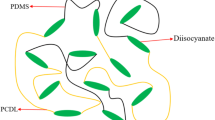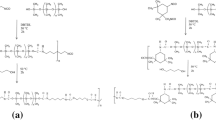Abstract
A series of poly(trifluoropropylmethyl)siloxane-block-polyurethane urea (PUUFS) films containing over 30 wt% poly(trifluoropropylmethyl)siloxane (PFS) were prepared via the three-step process that the prepolymer was synthesized from poly(tetramethylene oxide) (PTMO) and toluene diisocyanate (TDI), chain-extended with α,ω-bis(3-aminopropyldiethoxylsilane) poly(trifluoropropylmethyl)siloxane (APFS), and then with 3,3′-dichloro-4,4′-diaminodiphenylmethane (DDDPM). The films were formed through moisture curing and they were characterized using Fourier transform infrared spectroscopy, differential scanning calorimetry, scanning electron microscopy, X-ray Diffraction, dynamic mechanical analysis, thermogravimetric analysis, mechanical testing, and so on. The influence of the concentration ratios between hard and soft segments (CHS/CSS) on the microstructure and properties of the materials was investigated. Higher crosslink densities or extent of hydrogen bonding that result from higher hard segment concentrations enhanced the mechanical properties of the materials. The extent of the phase separation of materials initially decreased and then increased as the CHS/CSS elevated from 1.85 to 4.13. The material with a CHS/CSS of 3.01 exhibited the lowest phase separation and the highest crystallinity and tensile strength. In addition, the trend of the surface properties of the materials was similar to the change in tensile strength and associated with phase separation, hydrogen bonding, and crosslinkage. Moreover, the copolymer may have practical applications in coatings and adhesions.












Similar content being viewed by others
References
Jones RG, Ando W, Chojnowski J (2000) Silicon-containing polymers, the science and technology of their synthesis and applications. Kluwer Academic Publishers, Dordrecht, Section 1
Ward RS, Tian Y, White KA (1998) 216th ACS National Meeting, August 23–27, Boston, MA
White KA, Ward RS, Wolcott CA, Wong K (1995) The American Chemical Society Polymer Division Symposium, Polymer surface modification for biomedical applications. April 2–5, Anaheim, CA
Yilgor I, Riffle JS, Wilkes GL, McGrath JE (1982) Siloxane-urea segmented copolymers 1. Synthesis and characterization of model polymers from MDI and a, x-bis(aminopropyl) polydimethylsiloxane. Polym Bull 8:535–542
Chen J, Gardella JA Jr (1998) Solvent effects on the surface composition of poly(dimethylsiloxane)-co-polystyrene/polystyrene blends. Macromolecules 31:9328–9336
Koberstein JT, Russel TP (1986) Simultaneous SAXS-DSC study of multiple endothermic behavior in polyether based polyurethane block copolymers. Macromolecules 19:714–720
Mense CW, Yang XZ, Yang DC, Hsu SL (1992) Spectroscopic analysis of ordering and phase-separation behavior of model polyurethane in a restricted geometry. Macromolecules 25:925–932
Lelah MD, Cooper SL (1996) Polyurethane in medicine. CRC Press, Boca Raton, FL
Lee HS, Wang YK, Hsu SL (1987) Spectroscopic analysis of phase separation behavior of model polyurethanes. Macromolecules 20:2089–2095
Yilgor E, Unal S, Makal U, Yilgor I (2001) Influence of hydrogen bonding on the properties of silicone copolymers. Polym Prepr 42:120–121
Kajiyama M, Kakimoto MA, Imai Y (1990) Synthesis and properties of new multiblock copolymers based on dimethyl siloxane and N-phenylated polyureas. Macromolecules 23:1244–1248
Park HB, Kim CK, Lee YM (2002) Gas separation properties of polysiloxane/polyether mixed soft segment urethane urea membranes. J Membrane Sci 204:257–269
Su T, Wang GY, Xu XD, Hu CP (2006) Preparation and properties of waterborne polyurethaneurea consisting of fluorinated siloxane units. J Polym Sci Part A Polym Chem 44:3365–3373
Adhikari R, Gunatillake PA, Bown M (2003) Effect of polydimethylsiloxane macrodiol molecular weight on properties and morphology of polyurethane and polyurethaneurea. J Appl Polym Sci 90:1565–1573
Sakurai S, Nokuwa S, Morimoto M, Shibayama M, Nomura S (1994) Changes in structure and properties due to mechanical fatigue for polyurethanes containing poly(dimethylsiloxane). Polymer 35:532–539
Shibayama M, Suetsugu M, Sakurai S, Yamamoto T, Nomura S (1991) Structure characterization of polyurethanes containing poly(dimethylsiloxane). Macromolecules 24:6254–6262
Chen X, Gardella JA, Ho T, Wynne KJ (1995) Surface Composition of a Series of Dimethylsiloxane Urea Urethane Segmented Copolymers Studied by Electron Spectroscopy for Chemical Analysis. Macromolecules 28:1635–1642
Benrashid R, Nelson GL (1994) Synthesis of new siloxane urethane block copolymers and their properties. J Polym Sci Part A Polym Chem 32:1847–1865
Sha’aban AK, McCartney S, Patel N, Yilgor I, Riffle JS, Dwight DW, McGrath JE (1983) ESCA studies on poly(dimethylsiloxane)-urethane copolymers and their blends with segmented polyether-urethanes. Polym Prepr 24:130–133
Fan QL, Fang JL, Chen QM, Yu XH (1999) Synthesis and properties of polyurethane modified with aminoethylaminopropyl poly(dimethyl siloxane). J Appl Polym Sci 74:2552–2558
Adhikari R, Gunatillake PA, McCarthy SJ, Bown M, Meijs GF (2003) Low-modulus siloxane-based polyurethanes. Part II. Effect of chain extender structure on properties and morphology. J Appl Polym Sci 87:1092–1100
Adhikari R, Gunatillake PA, Mccarthy SJ, Meijs GF (2002) Low-modulus siloxane-based polyurethanes. I. Effect of the chain extender 1,3-bis(4-hydroxybutyl)1,1,3,3-tetramethyldisiloxane (BHTD) on properties and morphology. J Appl Polym Sci 83:736–746
Klein PG, Ebdon JR, Hourston DJ (1988) Polyurethane-polysiloxane interpenetrating networks: polyetherurethane-poly(phenylmethylsiloxane) systems. Polymer 29:1079–1085
Shi ZD, Wang XL (2009) Preparation and Characterization of Polyurethane-block- poly(trifluoropropylmethyl)siloxane Elastomers. Polym Advan Technol 12:1017–1023
Stanciu A, Airinei A, Timpu D, Ioanid A, Ioan C, Bulacovschi V (1999) Polyurethane/polydimethylsiloxane segmented copolymers. Eur Polym J 35:1959–1965
Sheth JP, Aneja A, Wilkes GL, Yilgor E, Atilla GE, Yilgor I, Beyer FL (2004) Influence of system variables on the morphological and dynamic mechanical behavior of polydimethylsiloxane based segmented polyurethane and polyurea copolymers: a comparative perspective. Polymer 45:6919–6932
Hoffman JJ, Leir CM (1991) Tetramethylammonium 3-aminopropyl dimethylsilanolate—A new catalyst for the synthesis of high purity, high molecular weight α, ω-bis(aminopropyl) polydimethylsiloxanes. Polym Int 24:131–138
Madhavan K, Reddy BSR (2006) Synthesis and characterization of poly(dimethylsiloxane-urethane) elastomers: Effect of hard segments of polyurethane on morphological and mechanical properties. J Polym Sci Part A Polym Chem 44:2980–2989
Shi ZD, Wang XL (2007) Synthesis of α,ω-bis(3-aminopropyldiethoxylsilane) Poly(trifluoropropylmethyl)siloxanes. e-Polymers no. 041
Flory PJ (1953) Principles of polymer chemistry. Cornell University Press, Ithaca, NY, p579
Bristow GM, Watson WF (1958) Cohesive energy densities of polymers 1. Cohesive energy densities of rubbers by swelling measurements. Trans Faraday Soc 54:1731–1741
Grulke EA (1989) In: Brandrup J, Immergur EH (eds) Polymer handbook, 3rd edn. John Wiley & Son, Canada, p519 (Chapter 7)
Liu FQ, Tang XY (1995) Polymer Physics. Higher Education Press, Beijing, p108 (Chapter 4)
Sheth JP, Klinedinst DB, Wilkes GL (2005) Role of chain Symmetry and hydrogen bonding in segmented copolymers with monodisperse hard segments. Polymer 46:7317–7322
Wang SK, Sung CSP (2002) Spectroscopic Characterization of Model Urea, Urethane Compound and Diamine Extender for Polyurethane-Urea. Macromolecules 35:883–888
Amrollahi M, Mir Mohamad Sadeghi G (2008) Evaluation of Adhesion Strength, Flammability, and Degradation of HBCD-Containing Polyurethane Adhesives. J Appl Polym Sci 110:3538–3543
Sekkar V, Gopalakrishnan S, Devi KA (2003) Studies on allophanate-urethane networks based on hydroxyl terminated polybutadiene: effect of isocyanate type on the network characteristics. Eur Polym J 39:1281–1290
Sekkar V, Bhagawan SS, Prabhakaran N, Rao MR, Ninan KN (2000) Polyurethanes based on hydroxyl terminated polybutadiene: modeling of network parameters and correlation with mechanical properties. Polymer 41:6773–6786
Chen RS, Chang CJ, Chang YH (2005) Synthesis and characterization of organosiloxane modified segmented polyether polyurethanes. J Polym Sci Part A Polym Chem 43:3482–3490
Zhang T, Xi K, Yu X, Gu M, Guo S (2003) Synthesis, properties of fullerene-containing polyurethane–urea and its optical limiting absorption. Polymer 44:2647–2654
Wang L, Shen YD, Lai XJ, Li ZJ, Liu M (2011) Synthesis and properties of crosslinked waterborne polyurethane. J Polym Res 18:469–476
Petrovic ZS, Zavargo Z, Flynn JH, Mackinght WJ (1994) Thermal degradation of segmented polyurethanes. J Appl Polym Sci 51:1087–1095
Grassie N, Zulfiqar M (1978) Thermal degradation of ammonium polymethacrylate and polymethacrylamide. J Polym Sci Polym Chem Ed 16:1563–1574
Wen J, Somorjai G (1997) XPS Study of Surface Composition of a Segmented Polyurethane Block Copolymer Modified by PDMS End Groups and Its Blends with Phenoxy. Macromolecules 30:7206–7213
Acknowledgments
We acknowledge the financial support of the Guangdong Province Natural Science Foundation of China (no. 10452902001005886).
Author information
Authors and Affiliations
Corresponding author
Rights and permissions
About this article
Cite this article
Shi, Z. Preparation and characterization of high-strength elastomers with high poly(trifluoropropylmethyl)siloxane content into polyurethane urea. J Polym Res 20, 57 (2013). https://doi.org/10.1007/s10965-012-0057-5
Received:
Accepted:
Published:
DOI: https://doi.org/10.1007/s10965-012-0057-5




